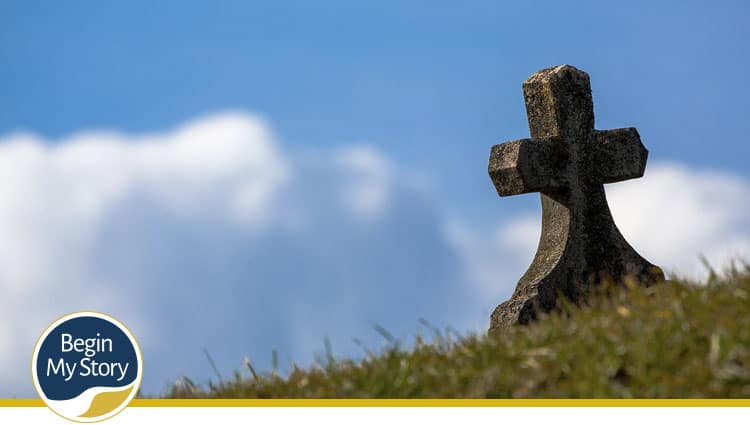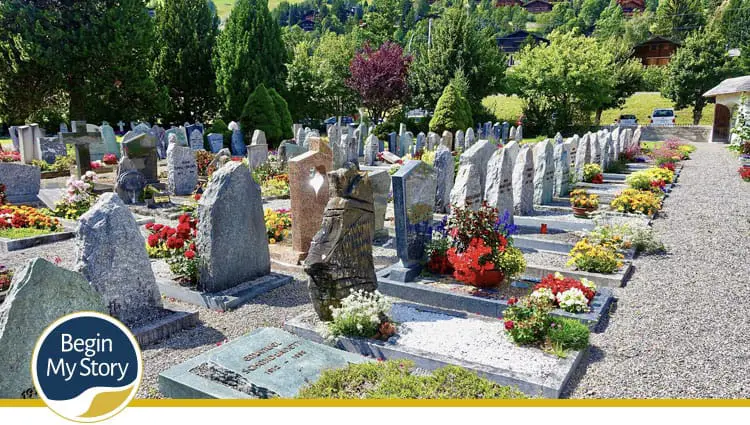
How to photograph the cemetery or graveyard for historical and ancestry research.
Over the centuries, several different types of stones have been used to create gravestones. Some of the stones are pretty porous and fragile, while others are resistant to damage. Be careful when attempting to improve the readability of the inscription. The following is a brief list of types of stone used in various periods:
- Before the nineteenth century: sandstone or slate.
- Nineteenth-century: marble and gray granite.
- Late nineteenth century to the present: polished granite or marble.
Table of Contents
TogglePhotograph the Cemetery and Graveyards
Photograph the cemetery entrance, sign, book of records, and church
Before you start taking photos of headstones, make sure you capture the details of the cemetery, including the name, street signs, proximity, and church adjacent to the cemetery. All these details will help you and others that follow know where you have been.
North, south, east, west: The best time of day for photographing headstones
Sunlight emphasizes imperfections in the stone and can make the carving look flat. Headstones facing west are best photographed at midday, and headstones facing north should be photographed in the late afternoon. Headstones facing south are well lit all day, and headstones facing east are best photographed in the morning hours.
Large headstones require close-ups of inscriptions
Taking photos of large headstones alone sometimes makes the inscription too small to read. Take a photo of the large headstone and then move close to take a photo of the inscription.
Family grave plots require group and individual photos of each headstone
A family plot constitutes two or more graves, and take a group photograph of the graves that shows the number and proximity. Take photos of each headstone separately. If you photograph a cemetery, photograph and label all family plots the same—for example, group plots, headstones left to right, top to bottom.
Consider taking photos of all headstones in a small community cemetery
If your family came from a small town and your roots go back many generations or many decades, you are related to most, if not all, persons buried in the cemetery. If you have traveled a great distance to capture family graves on film, take an extra hour or two and capture the other headstones on film, you can sort out details later. You will often find direct family members buried among other families.
Look at the base, top, sides, and back of headstones
In addition to the inscription, look around the headstone for other important information that can be inscribed about the individual, family, maker of the headstone, and writings of the deceased.

Take eye-level photos of headstone inscriptions
When taking photos of headstone inscriptions, try to take the photo of the inscription at eye level, and you will find information much easier to read in the photo.
Talk to the sexton
Can’t find a family member’s gravesite? See if you can talk to the sexton and ask to see the cemetery plot map. Sexton may have records you can simply photograph. Some cemeteries bury several layers deep to conserve space. In these situations, the headstone on top may only be for one of the several persons buried in the plot. Sometimes headstones are not available because the family is too poor for a headstone, but the sexton will have details of who is buried.
Take time to clear grass and other foliage away from inscription
Take time to clear any cut, dried grass away from and on top of the headstone before taking a photograph. If a branch is grown over the headstone, pull it back and take a photo. Clear overgrown grass to the edge of the marker or headstone. Important information or epitaphs may be separated from the main inscription (for example, a bronze marker denoting group or religious affiliation, service in a military branch, or that the individual fought in a specific war).
Use a little chalk for the hard-to-read, old headstones
Letters on the old stones are often hardly legible. Take a little piece of white (or black or any other dark color) chalk and fill in letters. Or rub the white chalk on the flat surface next to the letters.
Tilt your camera to the angle of the headstone
Older stones tend to lean or slant. Tilt the camera to the angle of the stone, and your image will straighten up nicely.
Black and gray polished marble shoots at an angle
Gray or polished black headstones are sometimes hard to read or reflect a camera’s flash, making the image illegible. Shoot polished headstone at an angle and then view on LCD for clarity. Re-shoot at a different angle if needed.

Try using a flash on headstones covered with shade or on cloudy days
Try using your flash if the inscription you just took a picture of is hard to read. The light should provide you with just enough extra light to fill in the dark shadows so you can read the lettering. Try using a flash from angles, if needed.
Try a soft brush or natural sponge and water to remove surface soil
Gentle brushing should remove surface dirt and bird droppings.
Try sponge and water on light-colored stone
The stone will darken from the water and darken the inscription on the stone.
Never use complex objects or stiff brushes to clean the stone
Keep a written record
Some of the items to consider as part of the written record include location, a map of the cemetery with the stones numbered, when photographed (time, date, and frame number), and transcription of the epitaph. Post your photos of headstones on family websites or sites such as Virtual Cemetery or Dead Fred.
When you take the time to prepare for your field research adequately, you will find tremendous success and better insight into the next steps you need to take in your research on the Internet and the field. I have prepared additional resources that you can download from the companion website, including a suggested genealogy packing list, personal packing list, and related resources
Additional Resources to Expand Your Knowledge
Consider expanding your knowledge beyond taking photographs for storytelling and ancestry research.
- Complete Historical and Genealogy Field Trip Research Guide
- Travel Packing List for Ancestry Research Field Trips
- Use Your Camera to Document and Photograph Ancestry Research
- How to Photograph the Cemetery for Ancestry Research
- How to Take Better Photographs for Ancestry Research
- How to Take Better Travel Photographs
- How to Take Better Close-up Photographs
- How to Take Better Outdoor Photographs
- How to Take Better People Photographs
- How to Use Photographs to Trace Ancestors
- How to Google Ancestor Photographs
- Travel Photography Tips






